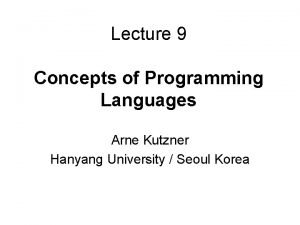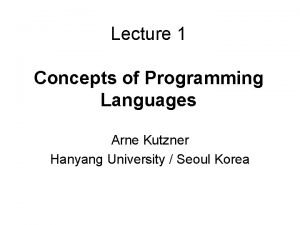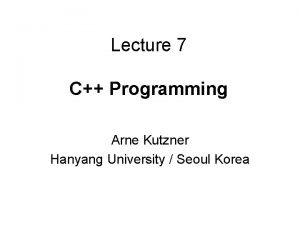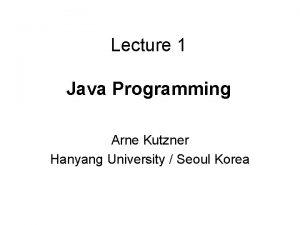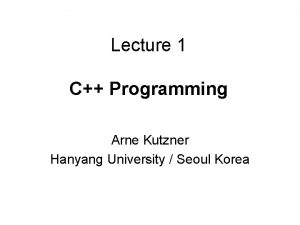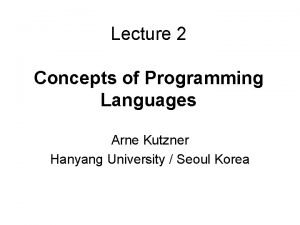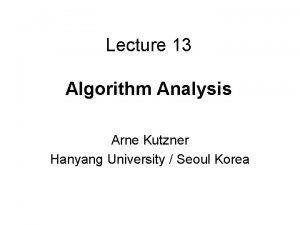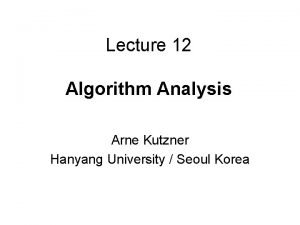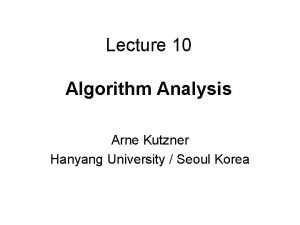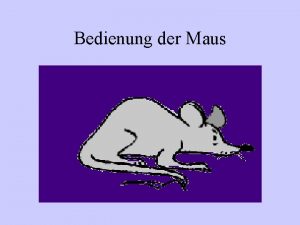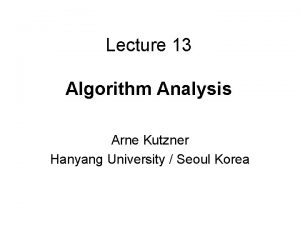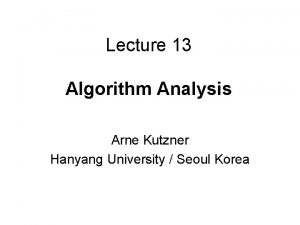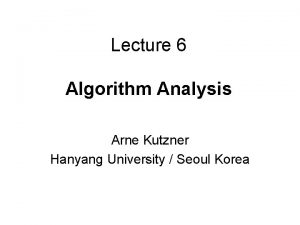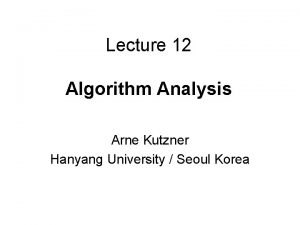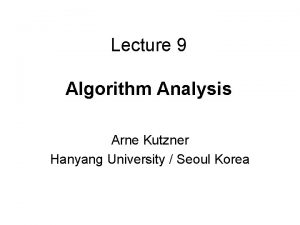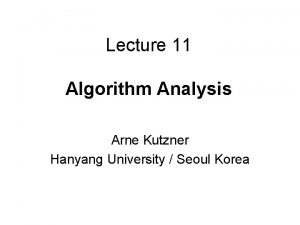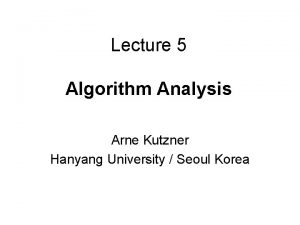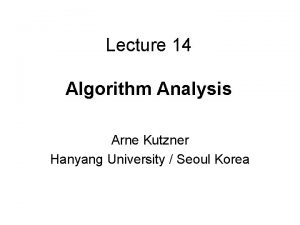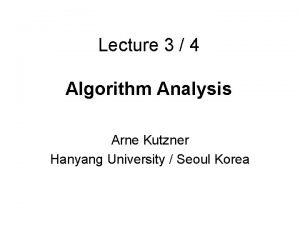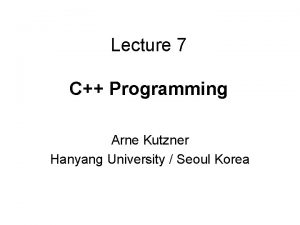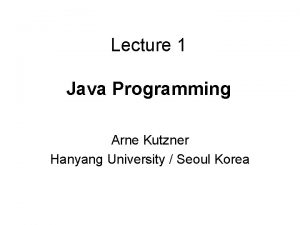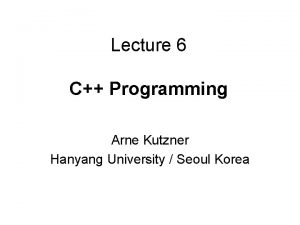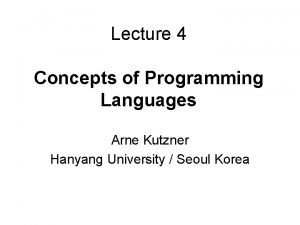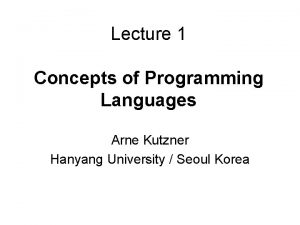Lecture 2 Algorithm Analysis Arne Kutzner Hanyang University



































- Slides: 35

Lecture 2 Algorithm Analysis Arne Kutzner Hanyang University / Seoul Korea

Overview • 2 algorithms for sorting of numbers are presented • Divide-and-Conquer strategy • Growth of functions / asymptotic notation Algorithm Analysis L 1.

Sorting of Numbers • Input A sequence of n numbers [a 1, a 2, . . . , an] • Output A permutation (reordering) [a’ 1, a’ 2, . . . , a’n] of the input sequence such that a’ 1 a’ 2 . . . a’n Algorithm Analysis L 1.

Sorting a hand of cards Algorithm Analysis L 1.

The insertion sort algorithm Analysis L 1.

Correctness of insertion sort • Loop invariants – for proving that some algorithm is correct • Three things must be showed about a loop invariant: – Initialization: It is true prior to the first iteration of the loop – Maintenance: If it is true before an iteration of the loop, it remains true before the next iteration – Termination: When the loop terminates, the invariant gives us a useful property that helps show that the algorithm is correct Algorithm Analysis L 1.

Loop invariant of insertion sort • At the start of each iteration of the for loop of lines 1 -8, the subarray A[1. . j-1] consists of the elements originally in A[1. . j-1] but in sorted order Algorithm Analysis L 1.

Analysing algorithms • Input size = number of items (numbers) to be sorted • We count the number of comparisons Algorithm Analysis L 1.

Insertion sort / best-case • In the best-case (the input sequence is already sorted) insertion sort requires n-1 comparisons Algorithm Analysis L 1.

Insertion sort / worst-case • The input sequence is in reverse sorted order • We need comparisons Algorithm Analysis L 1.

Worst-case vs. average case • Worst-case running time of an algorithm is an upper bound on the running time for any input • For some algorithms, the worst case occurs fairly often. • The „average case“ is often roughly as bad as the worst case. Algorithm Analysis L 1.

Growth of Functions Asymptotic Notation and Complexity

Asymptotic upper bound Algorithm Analysis L 1.

Asymptotic upper bound (cont. ) • Example of application: Description of what is the required number of operations of some algorithm in worst case situations. E. g. O(n 2) , where n is the size of the input – O(n 2) means the algorithm has a “square behavior” in the worst case. The O-notation allows us to hide scalars/constants involved in the complexity description. Algorithm Analysis L 1.

Asymptotic lower bound Algorithm Analysis L 1.

Asymptotic lower bound (cont. ) Examples of application: • Description of what is the required number of operations of some algorithm in best case situations. E. g. Ω(n), where n is the size of the input – Ω(n) means the algorithm has “linear behavior” in the best case. (The algorithm can still be O(n 2) in worst case situations!) • Description of what is the required number of operations in the worst case for any algorithm that solves some specific problem. Example: The required number of comparisons of any sorting algorithm in the algorithm’s worst case. (The worst case can be different for different algorithms that solve the same problem. ) Algorithm Analysis L 1.

Asymptotically tight bound Algorithm Analysis L 1.

Asymptotic tight bound (cont. ) • Example of application: Simultaneous worst case and best case statement for some algorithm: E. g. θ(n 2) expresses that some algorithm A shows a square behavior in the best case (A requires at least Ω(n 2) many operations for all inputs) and at the same time it expresses that A will never need more than “square many” operations (the effort is limited by O(n 2) many operations). Algorithm Analysis L 1.

Complexity of an algorithm • Complexity expresses the counting of performed operations of an algorithm with respect to the size of the input: – We can count only a single type of operations, e. g. the number of performed comparisons. – We can count all operations performed by some algorithm. This complexity is called time complexity. • Complexity may be (normally is) expressed by using asymptotic notation. Algorithm Analysis L 1.

Exercises • With respect to the number of performed comparisons: – What is the asymptotic upper bound of Insertion Sort ? – What is the asymptotic lower bound of Insertion Sort ? – Is there any asymptotically tight bound of Insertion Sort? • If yes: What is the asymptotically tight bound? • If no: Why is there no asymptotically tight bound? • If we move from counting comparisons to the more general time complexity, then are there any differences with respect to the three bounds? Algorithm Analysis L 1.

Merge-Sort Algorithm

Example merge procedure Algorithm Analysis L 1.

Merge procedure Algorithm Analysis L 1.

Merging – Complexity for symmetrically sized inputs • Symmetrically sized inputs (n/2, n/2) (here 2 times 4 elements) 67775558 – We compare 6 with all 5 and 8 (4 comparisons) – We compare 8 with all 7 (3 comparisons) • Generalized for n elements: – Worst case requires n – 1 comparisons – Exercise: Best case? – Time complexity cn = Θ(n). Algorithm Analysis L 1.

Correctness merge procedure • Loop invariant: Algorithm Analysis L 1.

The divide-and-conquer approach • Divide the problem into a number of subproblems. • Conquer the subproblems by solving them recursively. If the subproblem sizes are small enough, however, just solve the subproblems in straightforward manner. • Combine the solutions to the subproblems into the solution for the original problem Algorithm Analysis L 1.

Merge-sort algorithm • Divide: Divide the n-element sequence to be sorted into two subsequences of n/2 elements each. • Conquer: Sort the two subsequences recursively using merge sort. • Combine: Merge the two sorted subsequences to produce the sorted answer. Algorithm Analysis L 1.

Merge-sort algorithm Analysis L 1.

Example merge sort Algorithm Analysis L 1.

Analysis of Mergesort regarding Comparisons • When n ≥ 2, for mergesort steps: – Divide: Just compute q as the average of p and r ⇒ no comparisons – Conquer: Recursively solve 2 subproblems, each of size n/2⇒ 2 T (n/2). – Combine: MERGE on an n-element subarray requires cn comparisons ⇒ cn = Θ(n). Algorithm Analysis L 1.

Analysis merge sort 2 Algorithm Analysis L 1.

Analysis merge sort 3 Algorithm Analysis L 1.

Mergesort recurrences • Recurrence regarding comparisons (worst case) C C -1 • Recurrence time complexity: • Both recurrences can be solved using the mastertheorem: Algorithm Analysis L 1.

Lower Bound for Sorting • Is there some lower bound for the time complexity / number of comparisons with sorting? • Answer: Yes! Ω(n log n) where n is the size of the input • Later more about this topic …… Algorithm Analysis L 1.

Bubblesort • Further popular sorting algorithm Analysis L 1.
 Arne kutzner
Arne kutzner Arne kutzner
Arne kutzner Arne kutzner
Arne kutzner Arne kutzner
Arne kutzner Arne kutzner
Arne kutzner Arne kutzner
Arne kutzner Algorithm analysis
Algorithm analysis Prim's algorithm pseudocode
Prim's algorithm pseudocode Dfs algorithm
Dfs algorithm Safetyedu
Safetyedu Korea hanyang
Korea hanyang Blob 영상 다운로드
Blob 영상 다운로드 Hanyang
Hanyang 01:640:244 lecture notes - lecture 15: plat, idah, farad
01:640:244 lecture notes - lecture 15: plat, idah, farad Arne franz
Arne franz Arne friege
Arne friege Arne van heusden
Arne van heusden Arne fliflet
Arne fliflet Arne goerndt
Arne goerndt Arne bachmann
Arne bachmann Arne bartels
Arne bartels Arne ansper
Arne ansper Energisystemmodell
Energisystemmodell Arne venjakob
Arne venjakob Tincer cad
Tincer cad Erik sintorn
Erik sintorn Arne midjo
Arne midjo Arne wessberg
Arne wessberg Arne prasse
Arne prasse Svein arne trengereid
Svein arne trengereid Arne marjan mavčič
Arne marjan mavčič Arne svendsrud
Arne svendsrud Svein arne brygfjeld
Svein arne brygfjeld Arne menn
Arne menn Arne maus
Arne maus Arne fliflet
Arne fliflet
